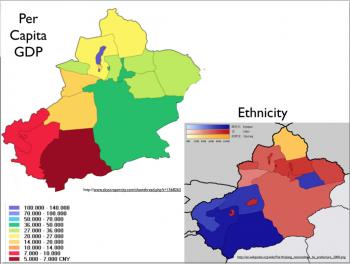Chinese government proposals intended as collective punishment, further marginalize the Uyghur people in southern East Turkestan

Birth control and “anti-terror” city proposals are ill conceived and target ordinary Uyghurs
For immediate release
August 20, 2014, 2:00pm EST
Contact: Uyghur American Association +1 (202) 478 1920
The Uyghur American Association (UAA) believes recent proposals put forward by Chinese officials will not address long-standing political, economic, social and cultural grievances in East Turkestan. The measures aim to collectively punish Uyghurs in southern East Turkestan for a rise in tensions.
A government scheme to build entire new settlements near to predominately Uyghur cities in southern East Turkestan and a plan announced by Xinjiang party secretary, Zhang Chunxian to limit minorities in the south of the region to one child per family will only sideline average Uyghurs and increase their distrust of Chinese authorities.
UAA also believes these proposals are not a sincere attempt to bring peace to the region, especially in the context of a series of policies that have exacerbated tensions in East Turkestan. Chinese officials can only bring genuine stability to East Turkestan with a fundamental reform of policies achieved through a meaningful dialogue that places Uyghurs as the decision makers in their future development.
“These proposals regarding the construction of ‘anti-terror’ cities and curbing Uyghur family size in southern East Turkestan are not only a demonstration of how short Chinese officials are on ideas, but also demonstrate that all Uyghurs in the south of the region are to be collectively punished for recent tensions,” said UAA president, Alim Seytoff in a statement from Washington, DC.
“Instead of tackling the root cause of Uyghur discontent in southern East Turkestan, the Chinese administration simply plans to reduce the absolute number of Uyghurs and ignore the endemic problems existing in the poverty stricken towns and villages of the area.”
Mr. Seytoff added: “Building new cities next to Uyghur settlements and bringing more Chinese settlers to the south tell Uyghurs the government attaches no importance to their grievances. Your choice is to suffer on the margins of society or assimilate with a version of development dictated by Han Chinese.”
According to a Bloomberg report dated August 6, 2014, Xinjiang party chief, Zhang Chunxian wrote in an essay about plans to reduce the number of births permitted to minorities. In an August edition of a party publication, Qiushi, he stated: “Southern Xinjiang will ‘implement family planning policy equally on all ethnic groups, to lower and stabilize an appropriate birth rate.'” Current policies permit urban Uyghurs to two children and rural Uyghurs to three.
Furthermore, an August 19, 2014 article in The Telegraph described a proposal to construct new cities and towns in southern East Turkestan with the assistance of the Han Chinese dominated Xinjiang Production and Construction Corps. Citing an article in the state-controlled publication, the Global Times, The Telegraph report stated that increased urbanization in southern East Turkestan would accelerate development in an area where “religious conservatism is prevalent and terrorist attacks occur more frequently.” The Telegraph report adds that one of the cities “will reportedly be near Hotan.”
UAA believes these new cities will encourage Han Chinese settlers to the south given the economic incentives cited in The Telegraph article and the Chinese government’s policy of “ethnic mingling” formulated at the second Xinjiang Work Forum in May 2014. Furthermore, the construction of new cities in southern East Turkestan will form part of a push to transform the area into a ‘settler-friendly’ environment, which includes the demolition of Kashgar Old City.
Development policies implemented in East Turkestan have had limited benefits in the southern part of the region, which is predominately populated by Uyghurs. The adoption of Western Development in 2000 as state policy and economic development initiatives stemming from the first Xinjiang Work Forum held in May 2010 have had little tangible effect in southern prefectures of East Turkestan.
The maps above, and available here, based on 2011 data illustrate the strong correlation between Uyghur ethnicity and low per capita GDP, especially in southern East Turkestan.
Image copyright GeoCurrents.
